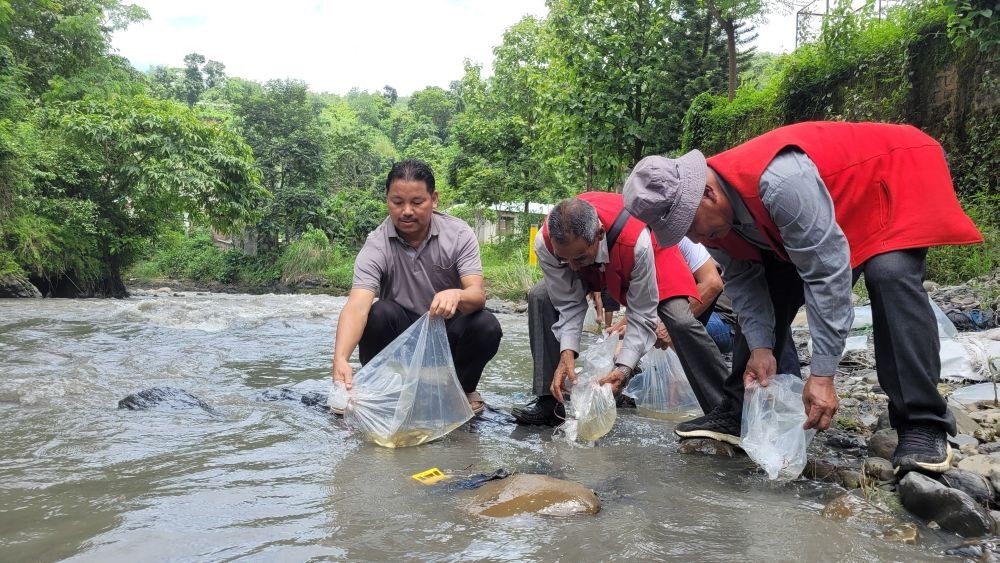Fingerlings being released by the Department of Fisheries & Aquatic Resources Nagaland and others release fingerlings at the Dzü-ü, a river in Japfü Range in the Southern Angami Region. (Morung File Photo: For Representational Purposes Only)

Kohima, April 17 (MExN): A study undertaken by Nagaland State Biodiversity Board (NSBB) has recorded a total of 567 aquatic sites in the 12 villages settled at the foothills of the Japfü Range, in the Southern Angami region.
These sites included include rivers/streams, springs, ponds and man-made water storage structures.
Further, a total of 65 aquatic faunal species and 48 floral species were also registered during what the NSSB termed as “a first-of-a-kind venture” documenting aquatic bio-resources and their associated traditional knowledge, good practices, findings, and recommendations in the region.
The study involved the preliminary quantitative assessment of the freshwater aquatic resources available in the 12 villages - Chakhabama/Sakhabama, Jakhama, Kezo Basa, Kezoma, Khuzama, Kidima, Kigwema, Mima, Mitelephe, Pfüchama, Phesama and Viswema.
With the assistance of the Biodiversity Management Committee of the respective villages, the NSSB not only documented aquatic bio-resources and but also documented associated Traditional Knowledge and good practices, informed a press release from the Board.
These aquatic sites assessed are major contributors of water resources to Dzü-ü and Sidzü rivers, the two important tributaries of the Doyang River, the biggest freshwater river in Nagaland.
The study will contribute to the preliminary assessment of the aquatic resources of the Doyang River, the NSSB said.
As per Board, the Northeastern Himalayas have created a unique freshwater biodiversity hotspot in North-East India, home to various endemic species, many of them, perhaps, still undiscovered.
Indigenous people and local communities in India are mandated to document valuable biological resources and traditional practices connected to each species and to this end, the intensive exercise of the “People’s Biodiversity Register” (PBR) have been very successful across the country, it said.
It further noted that documentation of aquatic species, especially in state of Nagaland, has mostly been ignored due to their tricky whereabouts in and around the streams and rivers and know-how, it added.
According, the Board held that PBR will serve as a baseline data for research related activities and will serve as important reference material for conservation planning and management of natural resources; for Environmental Impact Assessments; and for strategising, designing and implementation of various projects.
The study in Japfü range was conducted under the Indo-German bilateral cooperation project “Protection and Sustainable Management of Aquatic Resources in the Northeastern Himalayan Region of India” (NERAQ) Project with funding support from the German Federal Ministry for the Environment, Nature Conservation, Nuclear Safety and Consumer Protection (BMUV) under the International Climate Initiative (IKI). It is jointly implemented by the Deutsche Gesellschaft für Internationale Zusammenarbeit (GIZ) and Union Ministry of Environment, Forest and Climate Change (MoEFCC).
The NERAQ project is currently being implemented in Assam, Manipur, Meghalaya and Nagaland.
Meanwhile, the NSSB further inforemd that it is scaling up the preparation of PBR by carrying out similar exercises in 70 villages of Nagaland with support from another Indo-German project, Forest and Biodiversity Management in the Himalaya, Nagaland Project, which is supported by the KfW.





